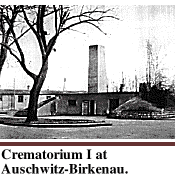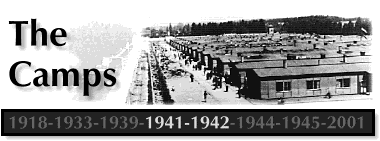In January 1942, SS  official Reinhard Heydrich held a meeting of Nazi government officials to present the Final Solution. At this meeting, known as the Wannsee Conference official Reinhard Heydrich held a meeting of Nazi government officials to present the Final Solution. At this meeting, known as the Wannsee Conference  , the Nazi officials agreed to SS plans for the transport and destruction of all 11 million Jews of Europe. The Nazis would use the latest in twentieth century technology, cost efficient engineering and mass production techniques for the sole purpose of killing off the following racial groups: Jews, Russian prisoners of war, and Gypsies (Sinti-Roma). Their long-range plans, unrealized, included targeting some 30 million Slavs for death. , the Nazi officials agreed to SS plans for the transport and destruction of all 11 million Jews of Europe. The Nazis would use the latest in twentieth century technology, cost efficient engineering and mass production techniques for the sole purpose of killing off the following racial groups: Jews, Russian prisoners of war, and Gypsies (Sinti-Roma). Their long-range plans, unrealized, included targeting some 30 million Slavs for death.
 Wannsee
Conference entry from the Encyclopedia of the Holocaust. Wannsee
Conference entry from the Encyclopedia of the Holocaust.
 Minutes of the Wannsee Conference planning the annihilation of over 11 million European Jews. Minutes of the Wannsee Conference planning the annihilation of over 11 million European Jews.
 Starting early in 1942, the Jewish genocide (sometimes called the Judeocide) went into full operation. Auschwitz 2 (Birkenau), Treblinka, Belzec, and Sobibór began operations as death camps. There was no selection process; Jews were destroyed upon arrival.
Starting early in 1942, the Jewish genocide (sometimes called the Judeocide) went into full operation. Auschwitz 2 (Birkenau), Treblinka, Belzec, and Sobibór began operations as death camps. There was no selection process; Jews were destroyed upon arrival.
Ultimately, the Nazis were responsible for the deaths of some 2.7 million Jews in the death camps. These murders were done secretly under the ruse of resettlement. The Germans hid their true plans from citizens and inhabitants of the ghettos by claiming that Jews were being resettled in the East. They went so far as to charge Jews for a one-way train fare and often, just prior to their murder, had the unknowing victims send reassuring postcards back to the ghettos. Thus did millions of Jews go unwittingly to their deaths with little or no resistance.
The total figure for the Jewish genocide, including shootings and the camps, was between 5.2 and 5.8 million, roughly half of Europe's Jewish population, the highest percentage of loss of any people in the war. About 5 million other victims perished at the hands of Nazi Germany.
 View hundreds of archival photographs of camps in the Resource section. View hundreds of archival photographs of camps in the Resource section.
 View hundreds of recent photographs of camps in the Resource section. View hundreds of recent photographs of camps in the Resource section.
 This
table gives the name, location, type, years of operation, closure, and present
status of the major concentration camps. This
table gives the name, location, type, years of operation, closure, and present
status of the major concentration camps.
 Many photographs of Buchenwald. Many photographs of Buchenwald.
 History of Buchenwald from the Encyclopedia of the Holocaust. History of Buchenwald from the Encyclopedia of the Holocaust.
 This site contains photos and maps of tunnels, shelters, and underground production facilities built with forced labor from nearby camps. This site contains photos and maps of tunnels, shelters, and underground production facilities built with forced labor from nearby camps.
 Soviet cameramen made the first pictures of the camp Auschwitz-Birkenau with its prisoners' barracks from the air. Soviet cameramen made the first pictures of the camp Auschwitz-Birkenau with its prisoners' barracks from the air.
 Slideshow
of Auschwitz and Birkenau camps by Scott Sakansky. Slideshow
of Auschwitz and Birkenau camps by Scott Sakansky.
 History of the Auschwitz camp from the Encyclopedia of the Holocaust. History of the Auschwitz camp from the Encyclopedia of the Holocaust.
 Information about Chelmno, the first Nazi extermination camp. Information about Chelmno, the first Nazi extermination camp.
 Notes on the Ravensbrück concentration camp for women. Notes on the Ravensbrück concentration camp for women.
 A collection of 11 articles about the Belzec, Sobibór, and Treblinka extermination camps. A collection of 11 articles about the Belzec, Sobibór, and Treblinka extermination camps.
 An extensive article about Treblinka from the Encyclopedia of the Holocaust. An extensive article about Treblinka from the Encyclopedia of the Holocaust.
 Article and photographs of the Sachsenhausen concentration camp. Article and photographs of the Sachsenhausen concentration camp.
 This article provides a concise history of the Majdanek camp. This article provides a concise history of the Majdanek camp.
 "Majdanek: Cornerstone of Himmler's SS Empire in the East" by Elizabeth B. White. "Majdanek: Cornerstone of Himmler's SS Empire in the East" by Elizabeth B. White.
 This article traces the phases of the Final Solution, from early resettlement plans, through ghettoization, to the death camps. This article traces the phases of the Final Solution, from early resettlement plans, through ghettoization, to the death camps.
 Nazi correspondence and reports on "medical" experiments carried out on camp inmates. Nazi correspondence and reports on "medical" experiments carried out on camp inmates.
 An extensive bibliography related to Nazi medical experimentation is available at the Wiesenthal Center site. An extensive bibliography related to Nazi medical experimentation is available at the Wiesenthal Center site.
 Nazi correspondence concerning plans to sterilize Jews needed as slave laborers for the Reich. Nazi correspondence concerning plans to sterilize Jews needed as slave laborers for the Reich.
 A lengthy article (with photographs) on Nazi medical experiments. A lengthy article (with photographs) on Nazi medical experiments.
 "Holocaust Numismatics," an article by Joel Forman about monetary systems used in concentration camps. "Holocaust Numismatics," an article by Joel Forman about monetary systems used in concentration camps.
 Richard Sufit's story of his captivity in Auschwitz and Buchenwald contains many details of camp life. Richard Sufit's story of his captivity in Auschwitz and Buchenwald contains many details of camp life.
 Staff Sgt. Albert J. Kosiek describes the liberation of Mauthausen and Gusen camps. Staff Sgt. Albert J. Kosiek describes the liberation of Mauthausen and Gusen camps.
 Article, maps, and photographs of the Stutthof concentration camp. Article, maps, and photographs of the Stutthof concentration camp.
By the end of 1943 the Germans closed down the death camps built specifically to exterminate Jews. The death tolls for the camps are as follows: Treblinka, (750,000 Jews); Belzec, (550,000 Jews); Sobibór, (200,000 Jews); Chelmno, (150,000 Jews) and Lublin (also called Majdanek, 50,000 Jews). Auschwitz continued to operate through the summer of 1944; its final death total was about 1 million Jews and 1 million non-Jews.
Allied encirclement of Germany was nearly complete in the fall of 1944. The Nazis began dismantling the camps, hoping to cover up their crimes. By the late winter/early spring of 1945, they sent prisoners walking to camps in central Germany. Thousands died in what became known as death marches.
 Map of major death marches and evacuations, 1944-45. Map of major death marches and evacuations, 1944-45.
 Fritzie Weiss Fritzshall describes a death march from Auschwitz and her escape into the forest. Fritzie Weiss Fritzshall describes a death march from Auschwitz and her escape into the forest.
 Interactive quiz on the camps. Interactive quiz on the camps.
 Lesson plans, discussion questions, term paper topics, reproducible handouts, and other resources for teaching about the camps are available here. Lesson plans, discussion questions, term paper topics, reproducible handouts, and other resources for teaching about the camps are available here.
| Nazi Party
| Nazification | Ghettos
| Camps
| Resistance
| Liberation
| Aftermath
|


A Teacher's Guide to the Holocaust
Produced by the Florida Center for Instructional Technology,
College of Education, University of South Florida © 2005.
| 
